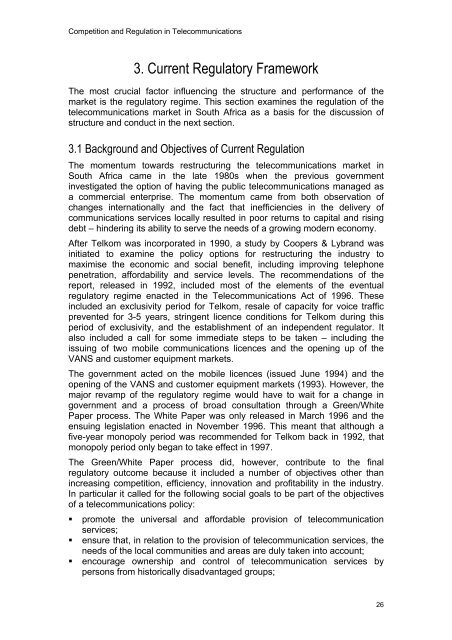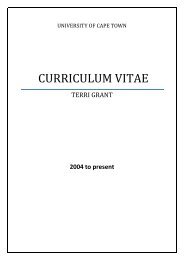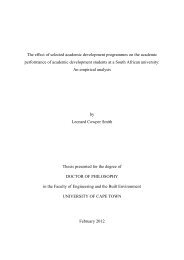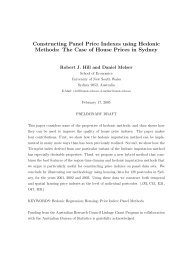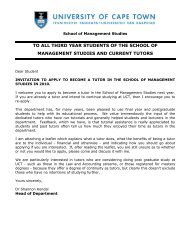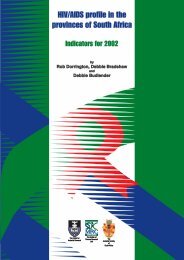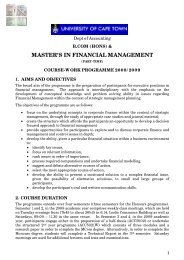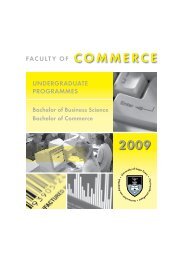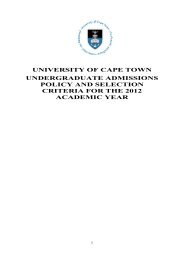Competition and Regulation in the Telecommunications Industry in ...
Competition and Regulation in the Telecommunications Industry in ...
Competition and Regulation in the Telecommunications Industry in ...
Create successful ePaper yourself
Turn your PDF publications into a flip-book with our unique Google optimized e-Paper software.
<strong>Competition</strong> <strong>and</strong> <strong>Regulation</strong> <strong>in</strong> <strong>Telecommunications</strong>3. Current Regulatory FrameworkThe most crucial factor <strong>in</strong>fluenc<strong>in</strong>g <strong>the</strong> structure <strong>and</strong> performance of <strong>the</strong>market is <strong>the</strong> regulatory regime. This section exam<strong>in</strong>es <strong>the</strong> regulation of <strong>the</strong>telecommunications market <strong>in</strong> South Africa as a basis for <strong>the</strong> discussion ofstructure <strong>and</strong> conduct <strong>in</strong> <strong>the</strong> next section.3.1 Background <strong>and</strong> Objectives of Current <strong>Regulation</strong>The momentum towards restructur<strong>in</strong>g <strong>the</strong> telecommunications market <strong>in</strong>South Africa came <strong>in</strong> <strong>the</strong> late 1980s when <strong>the</strong> previous government<strong>in</strong>vestigated <strong>the</strong> option of hav<strong>in</strong>g <strong>the</strong> public telecommunications managed asa commercial enterprise. The momentum came from both observation ofchanges <strong>in</strong>ternationally <strong>and</strong> <strong>the</strong> fact that <strong>in</strong>efficiencies <strong>in</strong> <strong>the</strong> delivery ofcommunications services locally resulted <strong>in</strong> poor returns to capital <strong>and</strong> ris<strong>in</strong>gdebt – h<strong>in</strong>der<strong>in</strong>g its ability to serve <strong>the</strong> needs of a grow<strong>in</strong>g modern economy.After Telkom was <strong>in</strong>corporated <strong>in</strong> 1990, a study by Coopers & Lybr<strong>and</strong> was<strong>in</strong>itiated to exam<strong>in</strong>e <strong>the</strong> policy options for restructur<strong>in</strong>g <strong>the</strong> <strong>in</strong>dustry tomaximise <strong>the</strong> economic <strong>and</strong> social benefit, <strong>in</strong>clud<strong>in</strong>g improv<strong>in</strong>g telephonepenetration, affordability <strong>and</strong> service levels. The recommendations of <strong>the</strong>report, released <strong>in</strong> 1992, <strong>in</strong>cluded most of <strong>the</strong> elements of <strong>the</strong> eventualregulatory regime enacted <strong>in</strong> <strong>the</strong> <strong>Telecommunications</strong> Act of 1996. These<strong>in</strong>cluded an exclusivity period for Telkom, resale of capacity for voice trafficprevented for 3-5 years, str<strong>in</strong>gent licence conditions for Telkom dur<strong>in</strong>g thisperiod of exclusivity, <strong>and</strong> <strong>the</strong> establishment of an <strong>in</strong>dependent regulator. Italso <strong>in</strong>cluded a call for some immediate steps to be taken – <strong>in</strong>clud<strong>in</strong>g <strong>the</strong>issu<strong>in</strong>g of two mobile communications licences <strong>and</strong> <strong>the</strong> open<strong>in</strong>g up of <strong>the</strong>VANS <strong>and</strong> customer equipment markets.The government acted on <strong>the</strong> mobile licences (issued June 1994) <strong>and</strong> <strong>the</strong>open<strong>in</strong>g of <strong>the</strong> VANS <strong>and</strong> customer equipment markets (1993). However, <strong>the</strong>major revamp of <strong>the</strong> regulatory regime would have to wait for a change <strong>in</strong>government <strong>and</strong> a process of broad consultation through a Green/WhitePaper process. The White Paper was only released <strong>in</strong> March 1996 <strong>and</strong> <strong>the</strong>ensu<strong>in</strong>g legislation enacted <strong>in</strong> November 1996. This meant that although afive-year monopoly period was recommended for Telkom back <strong>in</strong> 1992, thatmonopoly period only began to take effect <strong>in</strong> 1997.The Green/White Paper process did, however, contribute to <strong>the</strong> f<strong>in</strong>alregulatory outcome because it <strong>in</strong>cluded a number of objectives o<strong>the</strong>r than<strong>in</strong>creas<strong>in</strong>g competition, efficiency, <strong>in</strong>novation <strong>and</strong> profitability <strong>in</strong> <strong>the</strong> <strong>in</strong>dustry.In particular it called for <strong>the</strong> follow<strong>in</strong>g social goals to be part of <strong>the</strong> objectivesof a telecommunications policy:• promote <strong>the</strong> universal <strong>and</strong> affordable provision of telecommunicationservices;• ensure that, <strong>in</strong> relation to <strong>the</strong> provision of telecommunication services, <strong>the</strong>needs of <strong>the</strong> local communities <strong>and</strong> areas are duly taken <strong>in</strong>to account;• encourage ownership <strong>and</strong> control of telecommunication services bypersons from historically disadvantaged groups;26


